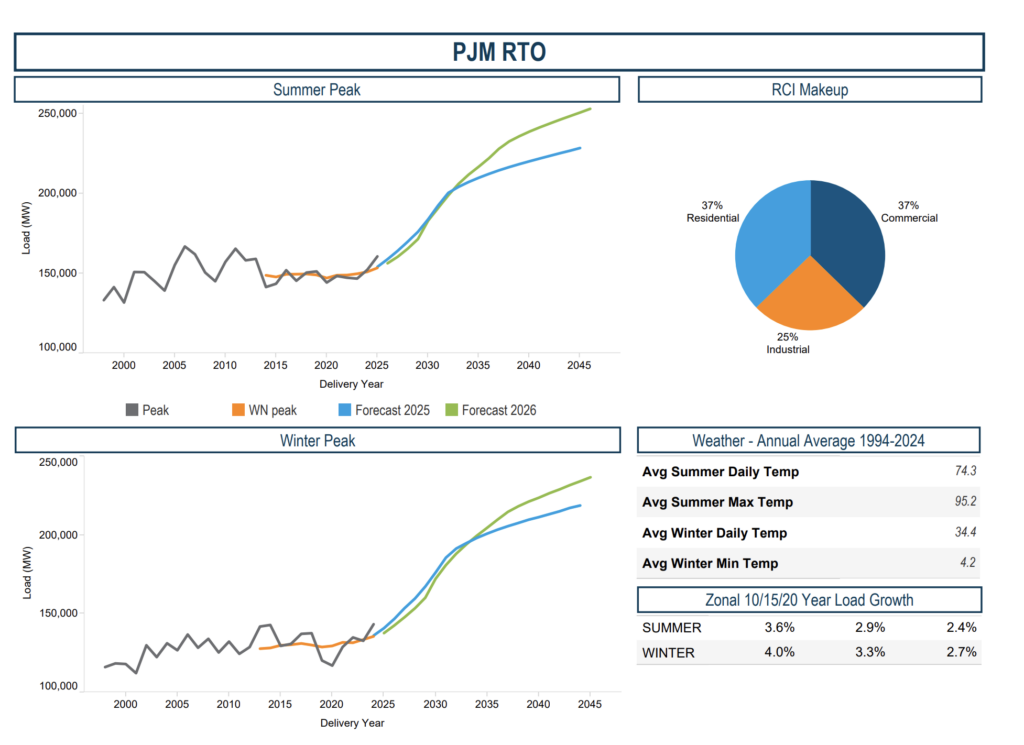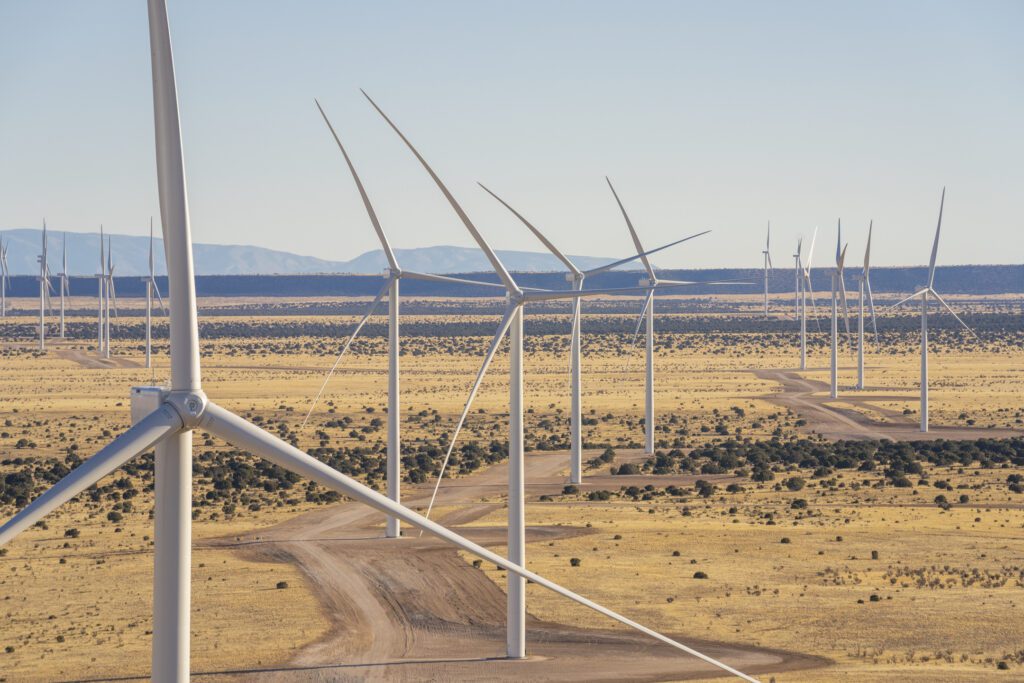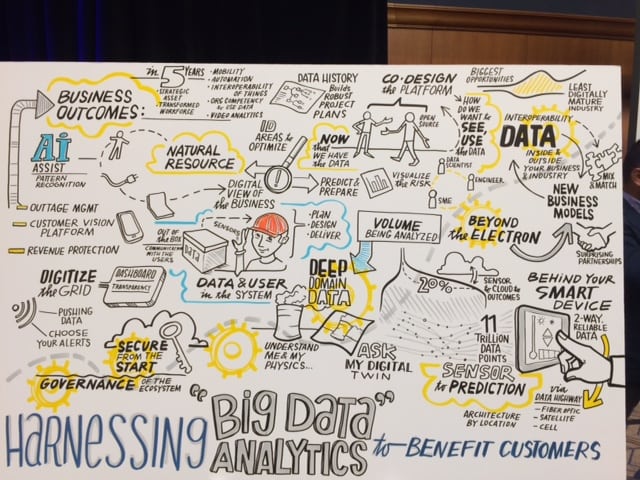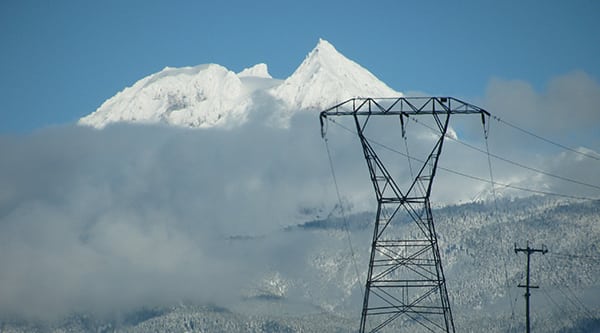At the Edison Electric Institute (EEI) annual meeting this week in Las Vegas, the tone was one of collaboration with partners from Washington to distributed generation companies. Those partnerships will be needed as the investor-owned utility (IOU) industry fights not so much a war on coal as a war for mindshare and wallet share in its encounters with customers large and small.
The EEI, a national association of IOUs and international affiliates and associates, has long been a prominent voice of the traditional electric utility. And those traditional utilities still reign supreme as the primary providers of electricity to U.S. homes and businesses. However, the greater penetration of distributed (especially renewable) generation (DG), smart grid technology, and consumer energy management tools has led some independent generators and customers to talk more seriously about the demise of the traditional utility, of reimagining the grid, or of disconnecting from it in favor of microgrids or DG plus energy storage.
The charge against incumbent “utilities of last resort” has long been that they are slow to change and have left themselves open to new business space being occupied by newcomers to the industry. There’s some proof of that in the spread of the multitude of renewable power providers dealing directly with consumers. And while there are some regulatory and legal reasons—as well as cultural ones—for utilities being slower to change than companies in other industries, it’s clear that the EEI at least has decided it’s time to go on the offensive.
Even the choice of opening and closing headliners—Former Deputy and Acting Director of the CIA Michael Morell and Former U.S. Secretary of Defense Robert Gates—helped set the tone of defending territory.
New Leadership
The official business of the meeting includes voting on a change of leadership. Outgoing EEI Chairman Michael Yackira, CEO of NV Energy, hosted the event. On June 10, the organization announced that Theodore F. “Ted” Craver, Jr., chairman, president, and CEO of Rosemead, Calif.–based Edison International, was elected chairman for the following year. Three vice chairmen were also elected: Nicholas K. “Nick” Akins, chairman, president, and CEO of Columbus, Ohio–based American Electric Power (AEP); Thomas A. “Tom” Fanning, chairman, president, and CEO of Atlanta-based Southern Company; and Christopher M. “Chris” Crane, president and CEO of Chicago-based Exelon Corp. Crane was not present at the meeting.
Positive Messaging
For decades, the complaint from those outside or on the edges of the industry has been that utilities, especially those operating in traditional, regulated environments, were slow to adopt new technologies, new business models, and new thinking generally. For some electricity customers and technology vendors, the pace of change for everything from renewable generation to smart grid–enabled customer control of energy use has been too slow. Now, in part because of changes forced upon the industry from externalities, including extreme weather events and social media, change is afoot.
The first day of the meeting included several signs that the IOU utility industry is changing.
Attendees saw it first in the form of signage, displays, and staff promoting a new advocacy campaign titled We Stand for Energy. At a macro level, according to an ambassador of the effort, an employee of the Washington, D.C., consulting firm retained by EEI to develop the program, the national effort is supposed to “educate” customers about the importance of electricity in their lives. The marketing materials’ answer to “Why are we building this community?” says the electric power industry “is transforming how electricity is made and delivered, and customers are changing how they use this power. This creates opportunities to engage with customers to ensure they better understand our energy opportunities and have a voice in the conversation.”
The campaign priorities include “Maintaining and transforming our nation’s electric power grid,” “Promoting accessibility and fairness,” “Using all sources of energy and developing new technologies,” and “Improving how Americans use electricity.” The subtexts of those goals are clear to anyone following the utility industry and include large capital investments needed for T&D, revenue issues around net metering of DG resources, the value of a diverse fuel portfolio, and issues involving everything from energy efficiency and load-shifting to electric vehicles.
For years, those in the electric utility industry have complained that the public doesn’t understand their business. The fact that the American public doesn’t understand other businesses any better (think financial services or healthcare or education, for starters) doesn’t help. The industry has argued internally that electricity is different in that virtually every activity of modern life relies on it. Now, it seems, the industry has decided to take responsibility for educating—or at least advocating—for the value of what it produces.
Craven commented in a Monday media briefing that the value of the grid is poorly understood and that “huge investment is needed.” Electric utilities invest $90 billion per year, he said. Yackira told the opening general session that the campaign is to advocate for smart energy solutions, to educate and engage customers and stakeholders on a wide range of topics.
Breakout sessions at the annual meeting took on topics from water to electric vehicles and from fuel diversity to distributed generation.
The CIA, Edison, and the Sage of Omaha
Monday’s opening general session, which packed a hall with somewhere around 1,000 attendees, ranged from the patriotic to the celebratory to the engaging. Michael Morell, former deputy and acting director of the CIA, spoke about four key moments in history to which he was witness: the 1998 Nairobi, Kenya, embassy bombing; the September 11 terrorist attacks; the events leading up to the mission that killed Osama bin Laden; and stories behind the names on the CIA’s memorial wall.
That sobering presentation was followed by the annual presentation of Edison Awards to U.S. and international winners. This year the American winner was Westar Energy for its innovative use of constructed wetlands to treat waste streams from its upgraded flue gas desulfurization system at the coal-fired Jeffrey Energy Center in northeast Kansas. Korea Southern Power Corp. Ltd. (KOSPO) won the international award for making a number of groundbreaking improvements to advance efficiency, reliability, and its organizational culture and to fulfill its social responsibility.
The awards presentation was followed by a light-hearted conversation among Yackira; Greg Abel, chairman, president, and CEO of Berkshire Hathaway Energy; and Warren Buffett, chairman and CEO of Berkshire Hathaway. Buffett, always a charming speaker with an optimistic attitude about America and its future prospects, said less than most expected about his interest in the energy industry. (Nevada host utility NV Energy is among Berkshire Hathaway Energy’s holdings.)
Buffett did, however, note that it’s important to address public opinion about and desire for distributed renewable energy and added that his company has spent $15 billion so far on renewables. He even supported the idea of using tax credits to change the market when the market won’t change on its own, so that society and government can direct investment for long-term benefit. Tax credits can be misused, he noted, but “It’s important that they be used.” Of course, tax credits are useful to a company that, according to Buffett, pays 2% of all U.S. corporate taxes.
Ranging more widely, when asked how industry is responding to cybersecurity threats, the Sage of Omaha, as he is often called, responded that “The problem is the offense is going to stay ahead of the defense,” so his companies are continually looking at how to fend off attacks.
On other energy policy issues, Buffett expressed support for the Keystone XL pipeline, noting that if it is not built, it will not stop the transport of the resource in other directions. He’s not in favor of exporting U.S. natural gas, however. Though the latest discoveries are large, the resource is “finite, and you should treat it as finite,” he said, adding that he’d just as soon see the rest of the world use its own resources rather than importing U.S. resources.
Praise for Federal Partners
Anyone expecting to hear loud complaints about federal regulation would have been disappointed by what was presented (at least in the public sessions). Akins, for example, commented in the Monday press briefing that the EEI had been working collaboratively with the Environmental Protection Agency (EPA) and other stakeholders on both the proposed carbon pollution standard—typically shorthanded as 111(d)—and the cooling water rule, 316(b). Regarding the water rule, Akins said the solution is “very fair” in how it was structured and provides flexibility to respond and that he is “very happy” with how it came out and with the fact that the EPA listened to industry.
As for the proposed standards affecting existing fossil-fired power plants, deriving from section 111(d) of the Clean Air Act, the EEI was a bit surprised, Akins said, in that it looks as if the base year is 2012, even though initial review of the EPA “Fact Sheets” focused on 2005, the “point of reference” year.
EEI leadership also praised Department of Energy (DOE) Deputy Secretary of Energy Daniel Poneman for his interactions with the industry, particularly during Hurricane Sandy. Several EEI leaders commented on their work with the DOE and Department of Homeland Security involving both natural disaster resilience and recovery and physical and cyber attack issues. Working with the federal government, Akins said, “has been just an amazing experience and a positive activity.”
Though Akins noted that “It’s a complicated time for the industry” on the resource and reliability side, the unified message was that the industry is working collaboratively with federal agencies and regulators. When asked how the EEI felt about outside groups claiming that 111(d) would be “the worst thing for the economy,” Craven said the industry wants to be “constructive and thoughtful” and that “to start by throwing bombs” instead of reading the rule was not constructive.
And there are cost concerns. Fanning made a point of noting in two different sessions that the average income of 48% of Southern’s customers is under $40,000 a year, which makes them sensitive to electricity costs. He and others also noted the importance of a diverse fuel portfolio, especially in light of the lessons learned from the past winter’s polar vortex. We need to preserve a place for nuclear and coal, he said on Tuesday’s EEI leadership panel.
Nevertheless, even Fanning had praise for those in government, especially in the context of partnerships in times of national emergency. The intersection of industry and government is working really well, he said; there’s “terrific collaboration” with the DOE and government to ensure resiliency. Poneman, he gushed, is “a fabulous public servant.”
Overall, unsolicited comments and responses to questions seemed to pointedly underscore that the industry has little to gain by taking an antagonistic posture relative to government agencies and regulators with whom these companies are in constant dialog.
Renewed Focus on Resiliency
Though there was some discussion of the newly unveiled carbon standard plan, there was almost no direct talk of climate change, even though there had been a closed Sunday subcommittee meeting on global climate change. Instead, the leadership’s position appears to be to talk about resiliency.
POWER noted in the Monday briefing that the Western Governors’ Association was meeting at the same time, specifically addressing issues of drought and flooding, and asked how EEI members anticipate their responses to extreme weather will affect the cost of service and rates. Though none of the EEI leaders responded to the cost part of the question, they focused on both traditional and newer approaches to resiliency and restoration.
Craven commented that, despite California’s sustained drought, the California Independent System Operator (CAISO) just released its summer readiness report and announced that the state has an expected 33% reserve margin. That’s thanks to transmission interconnections with the hydro-rich Pacific Northwest, which has historically been able to send excess power south to California during its summer peak, while California can send excess power north during that region’s peak during cooler months (a symbiotic relationship that isn’t available for all regions).
Akins noted that regional mutual aid agreements have been successful in responding to national events. He also pointed to new pole designs, undergrounding infrastructure, workforce preparation and development, and spare parts (especially transformers) management as ways the industry is attempting to develop a more resilient grid.
However, resiliency approaches such as burying lines can be site specific, as was pointed out in a dedicated session on resiliency. In addition to traditional resiliency strategies like tree trimming, newer strategies range from switching out wooden poles with steel ones and erecting concrete flood barriers around vulnerable substations.
Downplaying Disruptive Forces
Throughout the event, EEI speakers and distributed generation companies repeatedly said that utilities are in favor of DG but that they are all concerned about fair policies that adequately reflect the cost of maintaining a grid that can support growing amounts of DG.
In fact, on a Tuesday panel, Akins noted that when AEP used to think in terms of silos—generation, transmission, and distribution—the company used to spend the most on generation. But with lower load growth and the addition of DG, T&D now accounts for about 75% of its capital spending. Today, he said, “the most risky investment we make is on the generation side.”
At Monday’s press briefing, when asked about “disruptive technologies,” especially storage with DG, Craven said the bulk electric system facilitates all DG and storage, and argued that it’s inefficient to be separate from the distribution system. New technologies are good, he said, as they are giving customers benefits and choice.
Fanning opined, “I don’t think DG is particularly disruptive; storage is disruptive.” Southern is interested in the potential of large-scale storage, like compressed air energy storage, he said.
As for the difficulties that variable renewable DG might pose to a utility, Craven said, “This is the will of the people.” DG, storage, and greenhouse gas legislation may not be favored by everyone, but there’s public support and legislation backing it, “so our job . . . is to facilitate that” while ensuring safe, reliable, and affordable energy. “There is a little tension on the affordability side,” he granted, because California is a “beta tester.”
A Tuesday panel dedicated to DG titled “Getting Policies Right” drew a capacity crowd. The panel, moderated by Duke Energy President and CEO Lynn Good, included both solar power companies and utilities. Tom Werner, president and CEO of SunPower Corp., began by removing all doubt about any public animosities between the two sectors. “Solar,” he began, “is not going to replace the utility in our lifetime or our children’s, and the grid is necessary. We need utilities to exist and coexist.”
Jim Hughes, CEO of First Solar, noted that photovoltaic (PV) costs have dropped “at an astonishing rate,” giving utilities a cost-effective way to add fuel diversity. But policies for solar do need to be “right”—something that didn’t happen in Germany, he said, where First Solar had to shutter two manufacturing facilities.
Everyone in the session took pains to draw a distinction between the solar companies that were part of the panel and other providers that were viewed as sometimes speaking and acting inappropriately and even inaccurately. Don Brandt, chairman, president, and CEO of Pinnacle West Capital Corp. in Arizona noted that some firms imply that PV customers are leaving the grid or fail to disclose the fine points of the financial implications of rooftop solar leases. When customers don’t save the money that solar installers promised, those customers get angry and call the utility. The issue, he said, is a basic consumer protection one.
Connie Lau, president and CEO of Hawaiian Electric Industries, spoke about her state’s experience on the leading/bleeding edge of renewable penetration. The state has moved from looking at policies concerning technical issues involving interconnection to policies focused on community and societal issues involving renewable energy. She added that regulators recognize that costs should be fairly allocated, but it’s not simple to do, especially as customers highly favor solar. Some Hawaiian islands have more than 50% geothermal and variable renewables in their generation mix already.
Overall, the message from both entities was that they have more to gain by collaborating. Solar firms, Hughes said, are trying to “evolve” the utility model, not destroy the regulated monopoly utility. In Hughes’ view, the timeframe for revolution in energy systems is “faster than any of us can imagine.” He thinks that is true especially for energy storage. There’s no clear technology winner yet, but even now, storage can be economic in the commercial and industrial sector to reduce peak demand.
With reference to the Nest thermostat, he urged utilities to engage with regulators about how to adapt to new, unanticipated technologies before they emerge so they can get policies worked out ahead of time. The solar industry, he said, didn’t work with regulators early enough and doesn’t want to see the same problems encountered by other technologies.
Managing Workforce Changes
In both a dedicated session and general sessions, workforce issues were a matter of concern. Fanning commented that the industry needs more diversity in its companies because that diversity “gives you diversity of perspective and experience” and expands your scope of vision.
In a session titled “Building a Competitive Workforce for Tomorrow,” the panel noted that 30% to 60% of the workforce (depending on the company) is eligible for retirement in the next five to 10 years. That’s both a challenge and an opportunity to reshape the workforce, explained Geisha Williams, executive vice president of electric operations at Pacific Gas & Electric (PG&E).
Reshaping the workforce involves several things, including developing a workforce more reflective of the communities they serve, argued moderator Tom Graham, vice president of people strategy at Pepco Holdings.
John Donleavy, executive vice president and COO of National Grid, focused on the value and success of the Center for Energy Workforce Development and the Troops to Energy program (see also “Veterans Bring Needed Skills to the Utility Industry” in POWER’s June issue).
Rod West, executive vice president and chief administrative officer of Entergy, talked about the importance of organizational health and culture for ensuring better long-term performance. While utilities may want employees who contribute and stay their entire career, younger generations aren’t looking for that and instead want to see how they can move around in an organization. That requires a wider range of both skills and opportunities, especially in a world where utilities (often seen as less-than-cutting-edge employers) are competing against “the Googles and others.”
Bob Powers, COO of American Electric Power, focused on the importance of frequent and ongoing communication with labor. He also noted that part of the workforce challenge is that the country at large doesn’t value science, technology, engineering, and math (STEM) education, especially at lower levels. As a consequence, many would-be employees are poorly equipped for utility jobs.
One approach to addressing that problem was highlighted by Williams, who described PG&E’s Power Pathways Program, which partners with educational institutions to provide utility-specific education to diverse applicants in the communities where the utility needs new workers. Though the program, which pays for students’ training, isn’t a job guarantee, it positions them for success, and the system has included 50% veterans.
Change Agents
Craven commented that “The most important thing for our employees is that we have to accept that [the industry] is going to change.” Change isn’t new, but the pace may be faster, and though he said he doesn’t know what direction the change will go, he expressed the view that it’s “one of the most exciting times in the industry.” Akins noted that it’s “about ingenuity and innovation,” adding that the electric utility industry is in the best position because it’s not married to any particular resource—not just coal, for example.
Fanning added that utilities need to build “optionality”—including fuel options—into the business model. Southern has implemented an internal prize to encourage new ideas “to play offense in a new environment.” In this industry, “when we don’t try to solve the problems, others will step in,” he said.
The positive messaging, tone of partnership with everyone from Washington to DG firms, and the advocacy campaign are all signs that the IOU sector of the industry is recognizing that it has to make up for lost time on the change and innovation front. Another sign was the registered presence at the event of a relative “newcomer,” Google.
Though nobody I spoke with saw a nametag with Google on it, two Google representatives were listed as registered for the EEI event. Why? For starters, Google has become a significant investor in renewable energy and holds a wholesale power license. Though the company has been very quiet about its plans in the energy space, according to a Jan. 10 Bloomberg story, Google is developing a project called “Energy Access/Bottom Up Grid” and has posted at least two jobs for the effort: “one for a hardware engineer in power electronics and the other for a mechanical/thermal engineer. The project is slated to get to ‘mass production,’ according to one of the job listings.”
Bloomberg reported that Google “is in the early stages of building software and hardware tools to manage power lines and other infrastructure,” according to the sources, who “asked not to be identified because the matter is private.” Google’s Energy Access team, led by Arun Majumdar, vice president of the company’s energy unit, is leading the effort. Given the discussion to date about this sort of concept, it is likely to include microgrids, something EEI leadership did express concern over. Should there be a massive reliability incident, large energy users in particular would have greater reason to move to microgrids.
Bloomberg also quoted Steven Chu, former DOE secretary, as saying of Google during an interview last month at an energy conference in Fremont, Calif., “They recognize there is a huge wide-open space and that the utility companies are not stepping up to the plate.” Chu, who said he isn’t familiar with the plan but was just expressing his personal opinion, added, “They see a huge market opportunity.”
For years, electric utilities have bemoaned the fact that young people drawn to engineering fields have seen Silicon Valley as a more interesting and lucrative career target than utilities. Some day, that pool of new employees may not have to choose between Silicon Valley and working for a (new kind of) utility. Given utility control of the integrated grid, the EEI is betting that day is far into the future.
—Gail Reitenbach, PhD, Editor (@GailReit, @POWERmagazine)


















